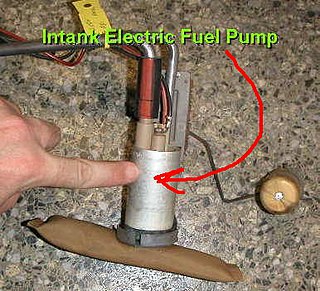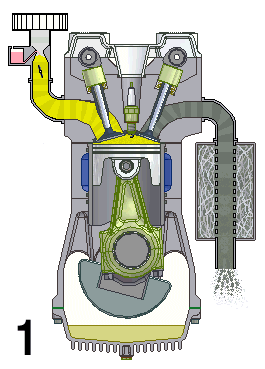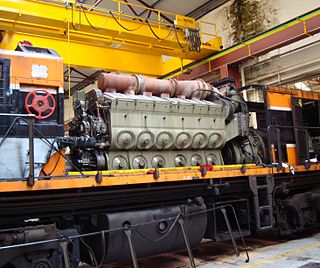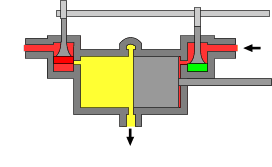Related Research Articles

The diesel engine, named after Rudolf Diesel, is an internal combustion engine in which ignition of the fuel is caused by the elevated temperature of the air in the cylinder due to mechanical compression; thus, the diesel engine is called a compression-ignition engine. This contrasts with engines using spark plug-ignition of the air-fuel mixture, such as a petrol engine or a gas engine.

A two-strokeengine is a type of internal combustion engine that completes a power cycle with two strokes of the piston in one revolution of the crankshaft. A four-stroke engine requires four strokes of the piston to complete a power cycle in two crankshaft revolutions. In a two-stroke engine, the end of the combustion stroke and the beginning of the compression stroke happen simultaneously, with the intake and exhaust functions occurring at the same time.

A straight-three engine is a three-cylinder piston engine where cylinders are arranged in a line along a common crankshaft.

A fuel pump is a component used in many liquid-fuelled engines to transfer the fuel from the fuel tank to the device where it is mixed with the intake air.

A naturally aspirated engine, also known as a normally aspirated engine, and abbreviated to N/A or NA, is an internal combustion engine in which air intake depends solely on atmospheric pressure and does not have forced induction through a turbocharger or a supercharger.
Indirect injection in an internal combustion engine is fuel injection where fuel is not directly injected into the combustion chamber.

The BMC B series was a line of straight-4 & straight-6 internal combustion engine mostly used in motor cars, created by British automotive manufacturer Austin Motor Company.

The EMD 645 is a family of diesel engines that was designed and manufactured by the Electro-Motive Division of General Motors. While the 645 series was intended primarily for locomotive, marine and stationary engine use, one 16-cylinder version powered the 33-19 "Titan" prototype haul truck designed by GM's Terex division
The Ford York engine is an inline diesel engine manufactured by Ford used in vehicles including the Ford Transit range of vans between 1972 and 1984.
A flat-eight engine, also called a horizontally-opposed eight, is an eight-cylinder piston engine with two banks of four inline cylinders, one on each side of a central crankshaft, 180° apart.

The EMD 567 is a line of large medium-speed diesel engines built by General Motors' Electro-Motive Division. This engine, which succeeded Winton's 201A, was used in EMD's locomotives from 1938 until its replacement in 1966 by the EMD 645. It has a bore of 8+1⁄2 in (216 mm), a stroke of 10 in (254 mm) and a displacement of 567 cu in (9.29 L) per cylinder. Like the Winton 201A, the EMD 645 and the EMD 710, the EMD 567 is a two-stroke engine.

The EMD 710 is a line of diesel engines built by Electro-Motive Diesel. The 710 series replaced the earlier EMD 645 series when the 645F series proved to be unreliable in the early 1980s 50-series locomotives which featured a maximum engine speed of 950 rpm. The EMD 710 is a relatively large medium-speed two-stroke diesel engine that has 710 cubic inches displacement per cylinder, and a maximum engine speed of 900 rpm.

The uniflow type of steam engine uses steam that flows in one direction only in each half of the cylinder. Thermal efficiency is increased by having a temperature gradient along the cylinder. Steam always enters at the hot ends of the cylinder and exhausts through ports at the cooler centre. By this means, the relative heating and cooling of the cylinder walls is reduced.

A two-stroke diesel engine is a diesel engine that uses compression ignition in a two-stroke combustion cycle. It was invented by Hugo Güldner in 1899.
The Commer TS3 was a diesel engine fitted in Commer trucks built by the Rootes Group in the 1950s and 1960s. It was the first diesel engine used by the company.
Internal combustion engines come in a wide variety of types, but have certain family resemblances, and thus share many common types of components.

Perkins Engines Company Limited, a subsidiary of Caterpillar Inc. since 1998, is primarily a diesel engine manufacturer for several markets including agricultural, construction, material handling, power generation, and industrial. It was established in Peterborough, England in 1932. Over the years, Perkins has expanded its engine catalogue, producing thousands of different engine specifications including diesel and petrol engines automatives.

An internal combustion engine is a heat engine in which the combustion of a fuel occurs with an oxidizer in a combustion chamber that is an integral part of the working fluid flow circuit. In an internal combustion engine, the expansion of the high-temperature and high-pressure gases produced by combustion applies direct force to some component of the engine. The force is typically applied to pistons, turbine blades, a rotor, or a nozzle. This force moves the component over a distance, transforming chemical energy into kinetic energy which is used to propel, move or power whatever the engine is attached to.
W.H. Dorman & Co was a company formed by William Henry Dorman in 1870 making cutting tools for the footwear industry. It diversified into other tools including grinders, and in 1903 into internal combustion engines. This was to be its main product up to the point where it was taken over by the English Electric Company in 1961, though the Dorman name continued as a diesel engine trademark until 1995. William Henry Dorman retired in 1911, and died in 1926.
References
- ↑ Boulton, David (May 2002). "The P6 Engine: A Design Ahead of its Time". Perkins Long Service Club.
- ↑ "The story of the 4.99 / 4.107 / 4.108 Engine - Perkins longserviceclub" . Retrieved 2 July 2015.
- ↑ "PERKINS ENGINES have turbocharged their four-cylinder 4.108 vehicle diesel and | 10th October 1981 | the Commercial Motor Archive".
- ↑ "THE P6 ENGINE - Perkins longserviceclub" . Retrieved 2 July 2015.
- ↑ "New Perkins "Flat" Engine | 19th September 1958 | The Commercial Motor Archive". Archive.commercialmotor.com. 19 September 1958. Retrieved 2 July 2015.
- ↑ "THE R6 ENGINE - Perkins longserviceclub" . Retrieved 2 July 2015.
- ↑ "PERKINS Ii iCES NEW | 21st October 1939 | The Commercial Motor Archive". Archive.commercialmotor.com. 21 October 1939. Retrieved 2 July 2015.
- ↑ "The 6.354 Story - Perkins longserviceclub" . Retrieved 2 July 2015.
- ↑ "Perkins shuts Shrewsbury engine plant - Farmers Weekly". 3 January 2002.
- ↑ "About Perkins 4006-23TAG2A". January 2019.
- ↑ "About Perkins 4006-23TAG3A". January 2019.
- ↑ "About Perkins 4008TAG1A". January 2019.
- ↑ "About Perkins 4008TAG2A". January 2019.
- ↑ "About Perkins 4012-46TAG3A". January 2019.
- ↑ "About Perkins 4012-46TAG2A". January 2019.
- ↑ "About Perkins 4012-46TWG3A". January 2019.
- ↑ "About Perkins 4012-46TWG2A". January 2019.
- ↑ "About Perkins 4016-61TRG2". January 2019.
- ↑ "About Perkins 4016-61TRG1". January 2019.
- ↑ "About Perkins 4016-61TRG3". January 2019.
- ↑ "Electric Power Generation | Perkins".
- Perkins Diesel Conversions & Factory fitted units, by Allan T. Condie, 2nd edition 2000, ISBN 0-907742-79-3
The 4 107T was used in UK Military electricity generating sets, the engines when in need an overhaul were rebuilt by a Kent based engineering works in Ramsgate, adjacent to the inner Harbour known as Walkers Marine (Marine Engineers) Ltd. Houchins of Ashford an MOD contractor would send an MOD inspector to verify dynamometer testing of power and smoke emissions both on start up and full power for one full hour (27 horsepower produced at 3000 rpm) being used near military front lines any excessive smoke whilst running would give the armies position away. When the transport vessel "Atlantic conveyor" was sunk during the Falklands conflict a large quantity of these generating units were lost. The engines were highly stressed due to turbo charging, the 4-107T used a Holset Brand turbocharger without after-cooling, and the longer 4-108 pistons with extended skirts, also a toughened tufftrided crankshaft, larger diameter cylinder head studs were used to contain the high combustion pressures. The engines when rebuilt could take up to four days of diligent running on the "Heenan and Froud" water dynamometer with great care given regarding application and duration of the load as minor tightening was not un-common, and a heavy seizure could result in disassembly and liner and piston replacement. But once run in the process of gaining full power with minimal rpm overshoot or droop or heavy black smoke was achieved by finely adjusting the injection timing and governor load springs in the CAV DPA injection pump.
Ian V Curtis recollections whilst an apprentice Diesel Engineer at Walkers Marine during the 1980s.